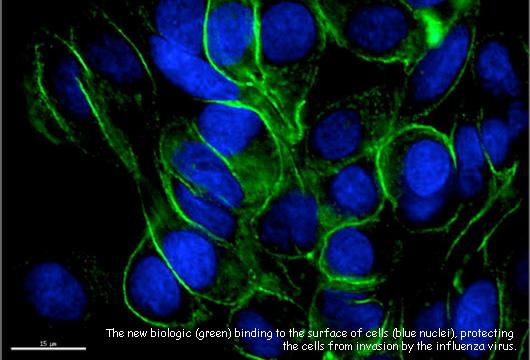New treatment could 'protect against any strain of the flu'
Scots scientists have developed a novel treatment that could protect against any strain of the flu.

It is hoped that the new development, led by researchers at the University of St Andrews and involving scientists at The Roslin Institute, has the potential to guard against current, future and even pandemic strains of the virus.In an international effort, the scientists involved say that the preventative treatment could be used as a 'frontline defence' before an effective flu vaccine is developed. Leading influenza experts say the new development is 'very exciting and potentially of great importance in this era'. The BBSRC and MRC-funded research was led by Professor Garry Taylor and Dr Helen Connaris in the Biomedical Sciences Research Complex at St Andrews.
We have developed an alternative host-targeted approach to prevent influenza by synthesising novel proteins, or biologics, that are designed to mask specific sugar molecules that line the respiratory tract.
The influenza virus, and indeed other respiratory pathogens, needs to bind to these sugars to gain entry to our cells to start the infection process.
The novel method was tested in mice by collaborators Dr Bernadette Dutia and Professor Tony Nash of The Roslin Institute at the University of Edinburgh and at St Jude Children's Research Hospital in Memphis.
Our research demonstrated that treatment with the biologics results in reduced virus replication in a mouse model and protected against lethal influenza infection. We also showed that the biologics bind to the epithelium of the lungs in infected mice.
This treatment provides an exciting approach to combat the threat of novel influenza infections.
Influenza remains a constant worldwide health threat with annual epidemics claiming up to 500,000 lives each year according to the World Health Organisation. The emergence of new strains from birds in recent years has revealed the remarkable ability of the virus to cross species barriers and to pose pandemic health threats. While vaccines are the cornerstone of prevention, these are not always effective and take time to develop in quantities needed to treat whole populations.
Antivirals are available, but the very recent Cochran report has highlighted the limited effectiveness of Tamiflu despite the UK government having spent almost £0.5billion on stockpiling the drug.
We anticipate our novel preventative approach being used as a frontline defense against new pandemic strains before an effective vaccine is developed, but the approach could also be used routinely against seasonal strains to protect health and care workers.
The recent Cochran study revealing the limited effectiveness of Tamiflu, which has been stockpiled by several governments at vast expense, shows how new approaches are required.
We believe that our approach has the potential to be used as a preventative against any current and new virus that emerges, such as H5N1, H7N9 and the very recent H10N8. Given that several other respiratory pathogens use the same entry route for infection, then our approach has a potentially broader application.
The study's authors are Helen Connaris, Lei Yang, Margaret Taylor, Sandra Tauber, Nadiawati Alias, Robert Hagan and Garry Taylor from St Andrews; Elena Govorkova and Robert Webster from St Jude Children's Research Hospital, Memphis; Yvonne Ligertwood, Bernadette Dutia and Tony Nash from The Roslin Institute, Edinburgh.
The study entitled "Prevention of influenza by targeting host receptors using engineered proteins" is published in the Proceedings of the National Academy of Sciences of the USA (PNAS): www.pnas.org/content/early/2014/04/09/1404205111.full.pdf+html?sid=8ffd6c7e-f162-455d-a45f-5da976577d7f
For more about this story please see: www.st-andrews.ac.uk/news/archive/2014/title,241585,en.php


